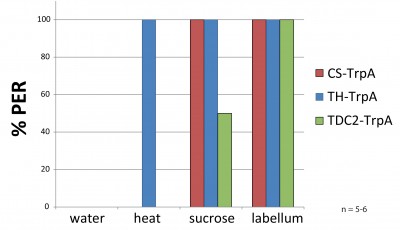Enes and Aslıhan joystick results of ATR and NOATR Control, ATR SifaG4 and ATR 13.0273 for yellow light.
on Wednesday, August 24th, 2022 10:32 | by Enes Seker
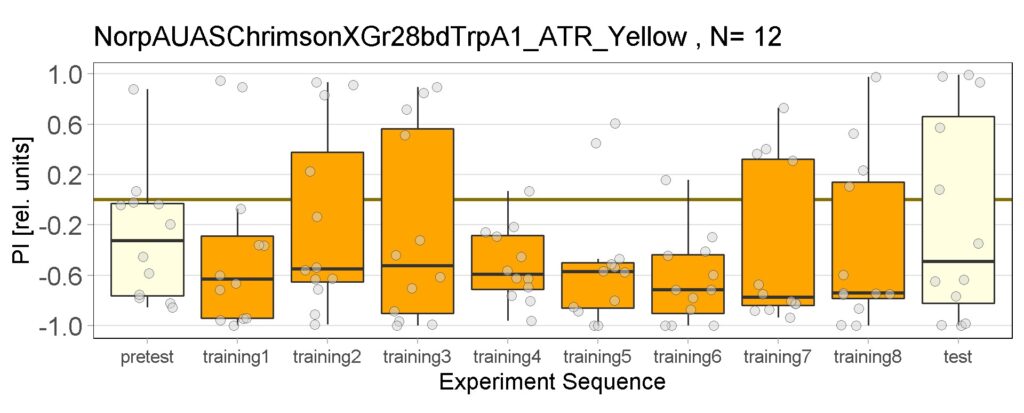
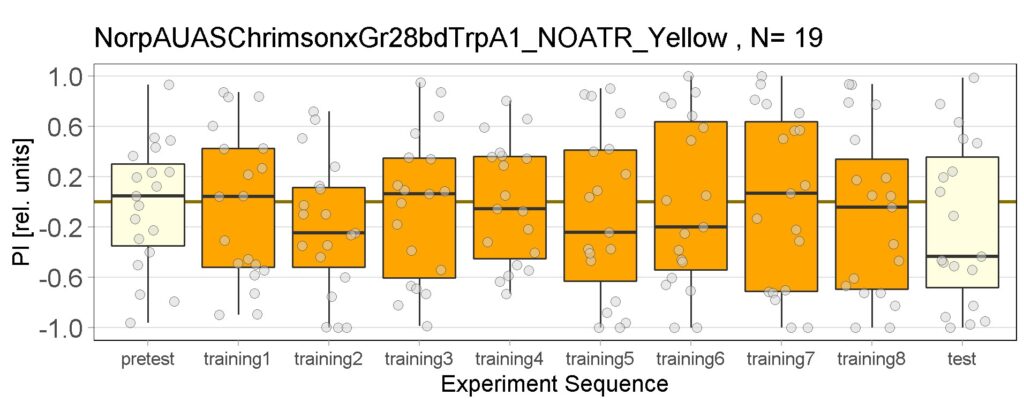

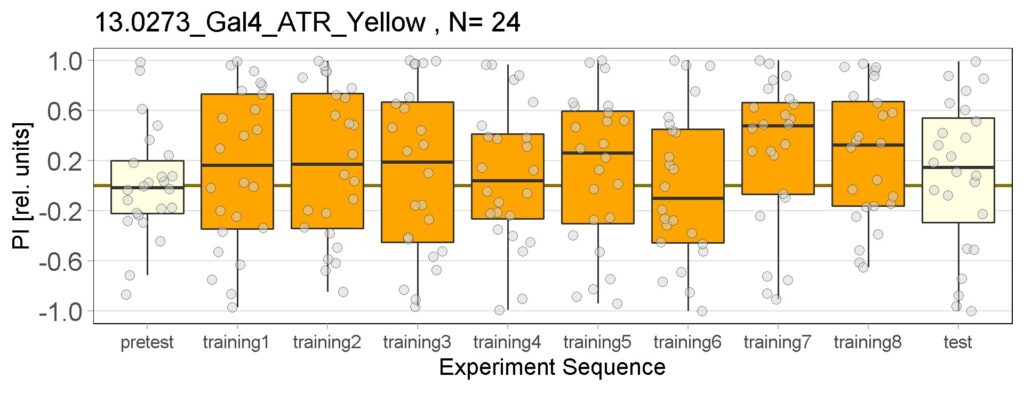
New experiments added for yellow light, ATR and NOATR Control group, ATR Sifa-G4 and ATR 13.0273-Gal4.
Category: Optogenetics, Uncategorized | No Comments
Role of dopaminergic neurons in operant behaviour
on Friday, July 27th, 2018 3:54 | by Gaia Bianchini
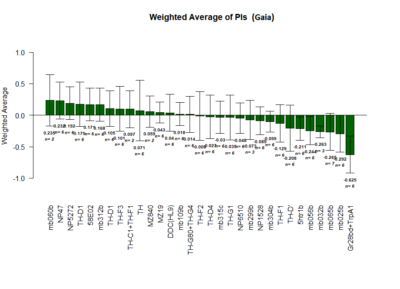
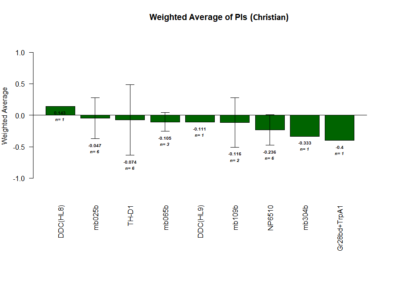
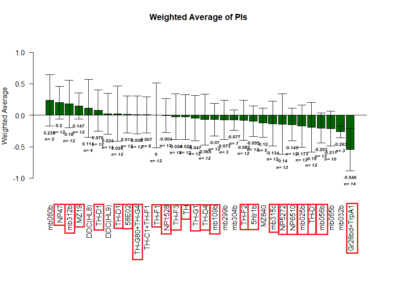
Positive Control: Gr28bd-G4, TrpA1-G4
Parameters: Light: intensity (500 Lux side, 1000 Lux bottom); frequency = 20Hz; Delay = 1 ms; Duration = 9.9 ms; volts = 6.4
Red lines: completed
mb025b: not selected against tubby
Tmaze Exploratory analysis : Middle Flies
on Monday, July 2nd, 2018 2:08 | by Naman Agrawal
plotting the mean ratio of flies which stay in the middle during experiment.
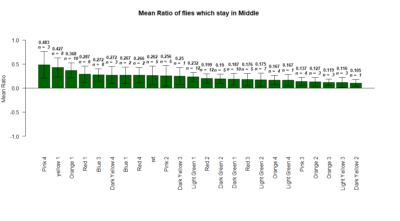
Yellow 1 (Positive Control): Gr28bd-G4, TrpA1-G4
Parameters:
Light: intensity (500 Lux side, 1000 Lux bottom)
frequency = 20Hz
Delay = 1 ms
Duration = 9.9 ms
volts = 6.4
Category: genetics, neuronal activation, open science, Optogenetics | No Comments
Tdc2 and Bruchpilot in flight
on Tuesday, March 26th, 2013 7:00 | by Christine Damrau
Tested the third cross. Now, it is around 15n each group. After a control experiment I preferred a recovery time of 1h instead of 5h. A short pilot for control groups showed that Tdc2virgins crossed to w1118males have a flight defect.
3rd
Category: Biogenic Amines, flight | 4 Comments
Usage of TrpA with infrared lamp
on Wednesday, February 13th, 2013 11:40 | by Christine Damrau
As a pilot for future experiments I tried to reproduce results from Keene et al., 2012. There, they substituted sugar by a laser to provoke PER after 24h of starvation (females, one week old). In TH-GAL4 they found 100% response when they pointed the laser to head or thorax. In tdc2-GAL4 indeed they found 50% of flies responding to heat but only when the laser was pointed to the thorax but not to the head.
Since we do not have this kind of laser, they used, I played around with an infrared light. Flies were fixed to hooks and a clamp as always. First, there was given a filter paper soaked with EVIAN-water (negative control), then there were 10s of heat (36-38°C), afterwards two positive controls: 30% sucrose on the legs and finally on the labellum.
In the figure, you can see that I am able to reproduce the methods with an infrared lamp instead of a laser. The TH-GAL4 flies crossed to TrpA respond much more to heat compared to the controls (see figure in blue and red). The proboscis extension appears already after a few seconds.
Unfortunately, I could not reproduce the results for tdc2-GAL4 (see figure in green). There was no response to heat found at all. (tdc2-GAL4 has to be ok, because I see fluorescence when crossed to GCaMP). Interestingly, the flies did not respond as strong to the 30% sucrose as expected. The starvation may have to be longer to increase motivation?
Next step will be to see a phenotype that can be seen by activating tdc2-GAL4. That may be PER after longer starvation or flight behavior.
Category: Biogenic Amines, crosses, genetics, neuronal activation, PER, TrpA | 1 Comment
c380 driven PKC inhibition
on Tuesday, December 18th, 2012 5:25 | by Julien Colomb
Unfortunately, the amount of data is a bit too low to draw conclusion, but if one look at the data for each fly:
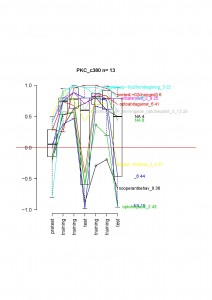
Only one fly not learning and the median would be 0. It looks very similar in the d42xPKCi cross, suggesting that the flies will also show the phenotype.
This will need to be confirmed next year with a new cross.
Other data visible at https://figshare.com/preview/_preview/104549
and later at doi: 10.6084/m9.figshare.104549
Category: operant self-learning, PKC, PKC_localisation | No Comments
Heat shock rescue of tßh-gene in Buridan’s paradigm
on Thursday, November 29th, 2012 12:50 | by Christine Damrau
The loss of tßh in adult flies leads to decreased walking speed and an increase in stripe fixation. Rescuing the gene by a heat shock construct (flies from Henrike Scholz, Cologne) increases walking speed back to wild type level but cannot change stripe fixation.
It is possible that the phenotype in stripe fixation is not exclusively tßh-dependent but more due to other problems the tßh-mutants have, e.g. developmental defects. That would ask for another heat shock timing.
Results:
– 1st cross
– 2nd cross
Flies:
– 1st cross (with heterozygous controls):
males females females
w1118,tßh/y ;; HStßh x w+,tßh//FM7 -> w1118,tßh//w+,tßh ;; HStßh//+
w1118,tßh/y x w+,tßh//FM7 -> w1118,tßh//w+,tßh
w1118,tßh/y ;; HStßh x w+ -> w1118,tßh//w+ ;; HStßh//+
w1118,tßh/y x w+ -> w1118,tßh//w+
– 2st cross (only mutants):
w1118,tßh/y ;; HStßh x w+,tßh//FM7 -> w1118,tßh//w+,tßh ;; HStßh//+
w1118,tßh/y x w+,tßh//FM7 -> w1118,tßh//w+,tßh
Heat shock timing:
Category: Biogenic Amines, buridan | 2 Comments
